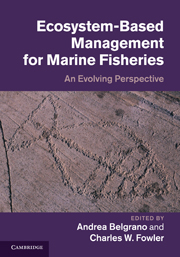Book contents
- Frontmatter
- Contents
- List of contributors
- Foreword
- Acknowledgments for cover artwork
- Introduction
- PART I CURRENT FORMS OF MANAGEMENT
- 1 Food-web and climate-related dynamics in the Baltic Sea: present and potential future applications in fish stock assessment and management
- 2 Northwest Atlantic ecosystem-based management for fisheries
- 3 Alaska marine fisheries management: advances and linkages to ecosystem research
- 4 A pragmatic approach for ecosystem-based fisheries assessment and management: a Korean marine ranch ecosystem
- PART II ELEMENTS OF IMPORTANCE TO MANAGEMENT
- PART III USING PATTERNS
- Afterword
- Index
- Plate section
1 - Food-web and climate-related dynamics in the Baltic Sea: present and potential future applications in fish stock assessment and management
from PART I - CURRENT FORMS OF MANAGEMENT
Published online by Cambridge University Press: 17 February 2011
- Frontmatter
- Contents
- List of contributors
- Foreword
- Acknowledgments for cover artwork
- Introduction
- PART I CURRENT FORMS OF MANAGEMENT
- 1 Food-web and climate-related dynamics in the Baltic Sea: present and potential future applications in fish stock assessment and management
- 2 Northwest Atlantic ecosystem-based management for fisheries
- 3 Alaska marine fisheries management: advances and linkages to ecosystem research
- 4 A pragmatic approach for ecosystem-based fisheries assessment and management: a Korean marine ranch ecosystem
- PART II ELEMENTS OF IMPORTANCE TO MANAGEMENT
- PART III USING PATTERNS
- Afterword
- Index
- Plate section
Summary
Abstract
The human influence on marine ecosystems is being recognized as a basis for extending the horizons of management. Historical anthropogenic influence has involved a wide variety of factors, including the effects of fishing on the dynamics of individual resource species. More inclusive complexity includes the interactions among species, and their interactions with other aspects of their biotic and physical environment. In this chapter, we review these elements of complexity for the central Baltic Sea. This ecosystem has a long history of human influence and its own special characteristics, due to its geographic location, geomorphic traits, and socio-political context. More and more of the complexity of this ecosystem is being recognized as scientists add to the wealth of documentation regarding the influence of surrounding terrestrial activities, monitor the dynamics of component populations, establish the effects of weather and climate, and illuminate the relationships among the various elements of the ecosystem. There is a great deal of historical information to characterize the changes that have occurred, not only among the various species making up the ecosystem, but also at the ecosystem level. Some of these have involved regime shifts, in part owing to climatic factors. Such significant changes involve more than one of the ecosystem's trophic levels as well as physical features such as salinity, temperature, and oxygen concentration. We begin to understand some of the complexity of ecosystems when we recognize that such factors are not alone, however, and realize that trophic cascade dynamics and feedback loops are also involved.
- Type
- Chapter
- Information
- Ecosystem Based Management for Marine FisheriesAn Evolving Perspective, pp. 9 - 31Publisher: Cambridge University PressPrint publication year: 2011
- 6
- Cited by



